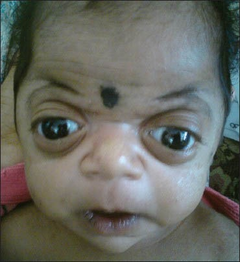Raine syndrome
| Raine syndrome | |
|---|---|
| Other names: Lethal osteosclerotic bone dysplasia | |
 | |
| This condition is inherited in an autosomal recessive manner | |
Raine syndrome (RNS), also called osteosclerotic bone dysplasia, is a rare autosomal recessive congenital disorder characterized by craniofacial anomalies including microcephaly, noticeably low set ears, osteosclerosis, a cleft palate, gum hyperplasia, a hypoplastic nose, and eye proptosis. It is considered to be a lethal disease, and usually leads to death within a few hours of birth. However, a recent report describes two studies in which children with Raine syndrome have lived to 8 and 11 years old, so it is currently proposed that there is a milder expression that the phenotype can take (Simpson 2009).
Symptoms and signs

The clinical presentation of this condition is as follows:[1]
- Microcephaly
- Flat nose
- Large fontanelles
- Retrognathia
- Microdontia
- Mandibular prognathia
- Mixed hearing impairment
- High palate
- Zygomatic flattening
- Pulmonary hypoplasia
- Short stature
Genetics
Raine syndrome appears to be an autosomal recessive disease. There are reports of recurrence in children born of the same parents, and an increased occurrence in children of closely related, genetically similar parents. Individuals with Raine syndrome were either homozygous or compound heterozygous for the mutation of FAM20C. Also observed have been nonsynonomous mutation and splice-site changes (Simpson et al. 2007).
FAM20C, located on chromosome 7p22.3, is an important molecule in bone development. Studies in mice have demonstrated its importance in the mineralization of bones in teeth in early development (OMIM, Simpson et al. 2007, Wang et al. 2010). FAM20C stands for “family with sequence similarity 20, member C.” It is also commonly referred to as DMP-4. It is a Golgi-enriched fraction casein kinase and an extracellular serine/threonine protein kinase. It is 107,743 bases long, with 10 exons and 584 amino acids (Weizmann Institute of Science).[citation needed]
Research
Current research describes Raine syndrome as a neonatal osteosclerotic bone dysplasia, indicated by its osteosclerotic symptoms that are seen in those suffering from the disease. It has been found that a mutation in the gene FAM20C is the cause of the Raine syndrome phenotype. This microdeletion mutation leads to an unusual chromosome 7 arrangement. The milder phenotypes of Raine syndrome, such as those described in Simpson’s 2007 report, suggest that Raine syndrome resulting from missense mutations may not be as lethal as the other described mutations (OMIM). This is supported by findings from Fradin et al. (2011), who reported on children with missense mutations to FAM20C and lived to ages 1 and 4 years, relatively much longer than the life spans of the previously reported children. Simpson et al.’s (2007) report states that to date, effected individuals have had chromosome 7 uniparental isodisomy and a 7p telomeric microdeletion. They had abnormal chromosome 7 arrangements, with microdeletions of their D7S2477 and D7S1484 markers (Simpson 2007).
History
It was first characterized in 1989 in a report that was published on an infant that had been born with an unknown syndrome, that later came to be called Raine syndrome.[2]
References
- ↑ "Raine syndrome | Genetic and Rare Diseases Information Center (GARD) – an NCATS Program". rarediseases.info.nih.gov. Archived from the original on 18 March 2021. Retrieved 2 August 2021.
- ↑ Raine J, Winter RM, Davey A, Tucker SM (December 1989). "Unknown syndrome: microcephaly, hypoplastic nose, exophthalmos, gum hyperplasia, cleft palate, low set ears, and osteosclerosis". J. Med. Genet. 26 (12): 786–788. doi:10.1136/jmg.26.12.786. PMC 1015765. PMID 2614802.
- FAMILY WITH SEQUENCE SIMILARITY 20, MEMBER C; FAM20C. (n.d.). Retrieved from OMIM website: http://omim.org/entry/611061?search=DMP4&highlight=dmp4#reference2 Archived 2021-04-21 at the Wayback Machine
- Family with sequence similarity 20, member C. (n.d.). Retrieved from Gene Cards website: https://www.genecards.org/cgi-bin/carddisp.pl?gene=FAM20C Archived 2021-04-21 at the Wayback Machine
- Fradin, M., Stoetzel, C., Muller, J., Koob, M., Christmann, D., Debry, C., ... & Doray, B. (2011).
- Osteosclerotic bone dysplasia in siblings with a Fam20C mutation. Clinical genetics, 80(2), 177-183.
- Kan, A. E., & Kozlowski, K. (1992). New distinct lethal osteosclerotic bone dysplasia (Raine syndrome). American Journal of Medical Genetics, 43(5), 860-864.
- Raine, J., Winter, R. M., Davey, A., & Tucker, S. M. (1989). Unknown syndrome: microcephaly, hypoplastic nose, exophthalmos, gum hyperplasia, cleft palate, low set ears, and osteosclerosis. Journal of medical genetics,26(12), 786-788.
- Simpson, M. A., Hsu, R., Keir, L. S., Hao, J., Sivapalan, G., Ernst, L. M., ... & Crosby, A. H. (2007). Mutations in FAM20C are associated with lethal osteosclerotic bone dysplasia (Raine syndrome), highlighting a crucial molecule in bone development. The American Journal of Human Genetics, 81(5), 906-912.
- Simpson, M. A., Scheuerle, A., Hurst, J., Patton, M. A., Stewart, H., & Crosby, A. H. (2009). Mutations in FAM20C also identified in non‐lethal osteosclerotic bone dysplasia. Clinical genetics, 75(3), 271-276.
- Wang, X., Hao, J., Xie, Y., Sun, Y., Hernandez, B., Yamoah, A. K., ... & Qin, C. (2010). Expression of FAM20C in the Osteogenesis and Odontogenesis of Mouse. Journal of Histochemistry & Cytochemistry, 58(11), 957-967.
External links
| Classification | |
|---|---|
| External resources |